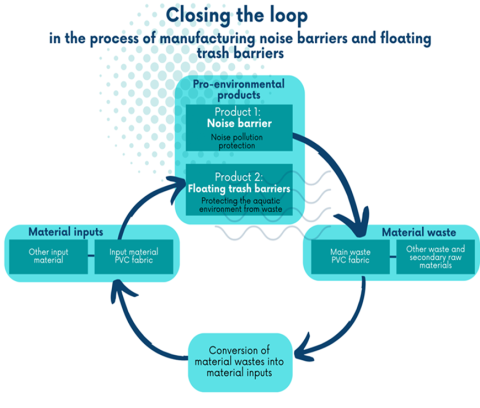
From waste to value – Circular economy approaches in noise barrier production

About this good practice
The circular economy is increasingly recognized as a sustainable alternative to the traditional linear economy, which follows a "take-make-dispose" model. In Slovakia, several companies have embraced circular practices, including Bamida, a Prešov-based producer of noise barriers. In collaboration with the Faculty of Management and Business, Bamida has integrated circular economy strategies, prioritizing resource efficiency, waste reduction, and innovative material reuse.
The company repurposes recycled textile waste in its noise barriers and aims to close its production loop by using manufacturing waste for secondary products. For example, PVC textiles that would normally be discarded are transformed into floating trash barriers to trap pollutants in watercourses and reservoirs, reducing environmental pollution. This approach not only cuts waste but also adds environmental and economic value.
Bamida uses tools like the Circular Canvas Model to identify areas for improving circularity in its operations. As it refines its processes, the company explores opportunities for multi-circularity, where waste is converted into materials for new products.
The positive outcomes of this practice are multifaceted: reduced waste, cost savings, and a reduced carbon footprint. Additionally, this model offers insights and scalable solutions that can be applied across other industries, making it a replicable example of circular economy in practice not only within Slovakia.
Resources needed
The good practice example of a circular economy was a part of the complex project BIN 02_2021_024 "Applied research for the improvement of acoustic properties of mobile noise barriers and ecological use of waste generated during their production " benefits from a 1 197 226 € through the EEA Grants.
Evidence of success
The implementation of CE principles at Bamida led to a significant reduction in waste produced in manufacturing process. A new environmentally friendly product, floating trash barriers, was developed from recycled PVC textiles. Additionally, the Circular Canvas Model was successfully applied, enabling a systematic analysis and enhancement of circular practices across the business. This innovative approach resulted in both economic and environmental benefits.
Potential for learning or transfer
The Bamida GP highlights potential for knowledge transfer in regions aiming to adopt circular economy principles in traditional industries. Key success factors include using the Circular Canvas Model, which provides a framework for assessing and enhancing circular practices. This model can be adapted by other businesses to close resource loops and innovate sustainably.
Strong partnerships between businesses and research community are crucial, combining strengths and expertise to boost innovation and sustainable development. Such collaborations can inspire other regions and industries to enhance sustainable outcomes.
Challenges in transferring these practices include differing regulations, market conditions, and material availability. However, regions focused on sustainability can benefit from integrating waste repurposing into production. This approach has potential for wider adoption across Europe, especially in regions seeking practical examples of circular economy implementation.
Further information
EEA Grants Bamida FMEO PU v Prešove
Images

Website
Good practice owner
You can contact the good practice owner below for more detailed information.